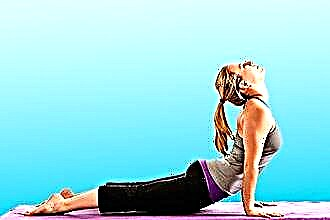Blood pressure is an important indicator of human health. Any deviation from the norm is considered a bad sign. In the case of a regular increase in its level, we can talk about the presence of hypertension in a person - a disease that significantly worsens the quality of life and its duration. First of all, blood vessels and heart suffer from hypertension. One of the reasons leading to vascular disorders and weakening of the heart muscle is physical inactivity - a sedentary lifestyle. Therefore, to the question of whether it is possible to play sports with hypertension, it would be logical to answer in the affirmative.

High blood pressure and sports
Sport is the best preventive measure for hypertension. But if the disease has already affected a person, this is not a reason to give up active exercises, but on the contrary - it is a signal that you urgently need to start introducing regular training into your life.
Physical activity for hypertension is not only acceptable, but also desirable. Thanks to physical education, muscles and bones, the cardiovascular system are strengthened, the general endurance of the body improves.
In addition, the fact is reliable: blood pressure during physical exertion of moderate intensity begins to gradually decrease. But not every sport is allowed to be engaged with a diagnosis of arterial hypertension. But a specially selected set of exercises is suitable even for experienced hypertensive patients. What are the benefits of physical education for hypertension:
- metabolism accelerates;
- extra pounds go away;
- the heart trains, the blood vessels expand, become more elastic;
- improves blood flow;
- organs are enriched with oxygen;
- the mood rises;
- sleep is normalized.
Exercise for hypertension should be enjoyable, only then will it be effective. The loads should be moderate and regular, their intensity should increase gradually, it is important to observe the principle: from simple to more complex.
Before starting training, a hypertensive person must coordinate his actions with a doctor, undergo the necessary examination.
At a minimum, you need to do an ECG and measure the pressure, the doctor must determine the stage of development of the disease. When drawing up a lesson plan, the following factors should be taken into account:
- the minimum number of workouts that is necessary to achieve the result;
- the maximum possible load at which the body will not be harmed;
- the expediency of practicing a certain kind of sport in the presence of hypertension;
- total duration of one workout;
- exercises prohibited for hypertensive patients;
- recommended exercises;
- alarms for stopping training;
- ways to control pressure during and after training.
You need to do it at least three times a week, 30 minutes will be enough. Any activity should be started with a warm-up.
It is useful to start the morning with exercises, and you can and should start doing it without getting out of bed, gradually kneading all the muscles and joints.
It is imperative to monitor the pressure during training, for this you can calculate the pulse by holding a vein in your hand with two fingers: it should not exceed 180-200 beats per minute.
What sport is suitable for hypertension:
- walking;
- calm running;
- water gymnastics;
- yoga (not all exercises are suitable);
- moderate intensity aerobics;
- cycling trips;
- skiing;
- swimming in the pool;

- gymnastics, in which not rhythmic movements prevail, but stretching exercises.
Physical exercises can be divided into two types according to the type of load: loads are of aerobic (isotonic) and anaerobic (isometric) nature. Aerobic loads occur during dynamic or cyclic exercises (running, walking, water gymnastics, skiing, cycling). Workouts are carried out at the same pace without interruption for a long period of time, they are distinguished by moderate intensity. At the same time, the body is actively saturated with oxygen, its endurance improves.
Anaerobic training is strength exercises (bodybuilding, rock climbing, jumping rope, sprint running, high-speed cycling, rhythmic gymnastics with elements of strength fitness), which are done in several approaches, are characterized by maximum muscle tension in short periods of time, alternating with minutes of rest ... This training, during which the body experiences a lack of oxygen, they are also called "oxygen-free", they are aimed at strengthening muscle strength and building muscle mass. Everything here must be done quickly, in jerks, as intensely as possible.
For hypertensive people, aerobic training can be recommended, and it is better to refrain from anaerobic sports. Although with a competent approach, under the supervision of a doctor and a professional trainer, in the initial stages of hypertension, you can also work out in the gym. Read more about some sports for hypertensive patients.
Walking... It is the most acclaimed sport for hypertension, enjoyable and suitable for everyone. You can walk when getting to work or returning from it, it is advisable to walk up to the upper floor without using the elevator. To begin with, it is advisable to walk one and a half or two kilometers a day, repeating workouts three times a week, you can gradually speed up the pace of walking and increase the distance traveled (after two weeks, you can add half a kilometer). The optimal load for one training session with hypertension will be a path of 4 km, which must be covered within an hour. It is imperative to monitor your pulse. Walking is a great option for aspiring hypertensive athletes. If the body is accustomed to the proposed loads, those who wish can switch to jogging.
Run... It brings pressure back to normal and promotes healing of the whole organism. Cyclic movement and moderate load dilates blood vessels, ensures the outflow of blood to the legs. Exercises on a treadmill strengthen legs, remove extra pounds, enrich organs with oxygen, and normalize the nervous system. Some helpful tips for aspiring runners with hypertension:
- You need to run regularly, every day and in any weather, preferably at a certain time.
- Before jogging, be sure to stretch your joints and stretch your muscles in the process of a little warm-up.
- The aim is to increase the running time, not the running speed.
- You can start at 15 minutes, increasing your jogging time by 5 minutes after every two workouts.
- The maximum time for one workout is 40 minutes (4 km); having achieved this result, you can gradually reduce the load to one kilometer, then take a break (one day), and then slowly increase the time and distance again; observing such a training scheme, you can get a good effect from training without overworking.
- If the heart rate during running has exceeded the permissible norm, or signs of poor health appear, the exercises should be stopped, and the next workout should be carried out with a lower load.
- The permissible heart rate is calculated using the formula: 220 is the number that matches the runner's age.
- The heart rate should be restored after training no longer than 5 minutes, and breathing - no longer than 10 minutes, otherwise the load should be reduced.
- You need to run after a light breakfast, not earlier than an hour later; while running, you can drink a little water.
- Jogging is good at any convenient time of the day, but not in heat or severe frost.
- After finishing your running workout, you need to lie down with your legs raised above the location of your heart.

Yoga... Not all types of exercise are suitable for hypertension.Breathing exercises according to the yoga system are very useful. Performing the recommended exercises correctly and regularly will lower your blood pressure. What not to do:
- Allow an increase in heart rate, the appearance of red spots on the face, an increase or decrease in intracranial pressure during exercise.
- Do exercises that require you to interrupt your breathing.
- Poses are unacceptable: inverted asanas, power, long-term fixing a certain position of the body, postures with a deep bend of the back, with raising the hips and legs, lying on the floor; you cannot do a headstand or shoulder stand.
Allowable Exercises
The first rule when doing any type of exercise is not to overdo it. Overwork will bring the opposite result - the pressure after physical activity without proper preparation will only increase. In addition, there are some exercises that should be prohibited for hypertension.
- Heavy lifting exercises.
- Static load on certain muscles, while the whole body is motionless, permanently fixed in one position.
- Rhythmic activities, which are characterized by a sharp change in movements.
- Exercises that require tilting the head downward put intense stress on the back and neck.
- Exercises that require throwing the head back, holding the breath, raising the legs above the level of the head.
- Any kind of jumping.
- Throwing at the target.
- Fast sprinting, shuttle running.
- Fast squats and fast stairs.
- Rope climbing.
Signals to stop exercising:
- increased pressure (especially sudden and strong);
- cardiopalmus;
- severe shortness of breath;
- pain, heaviness, burning sensation in the region of the heart;
- the appearance of blackheads or darkness before the eyes;
- there was a noise in the ears, dizzy;
- an attack of nausea;
- swelling;
- numbness of the arms or legs, face, jaw, neck.
Since with elevated pressure, smooth movements and a calm pace of their implementation are recommended, stretching exercises are perfect in this situation. This type of physical exercise strengthens the whole body, makes it flexible, plastic, trains the heart without tiring it. It is enough to train for 15 minutes every day. A good stretch can serve as a preparatory step for the transition to heavy-duty exercises.
Dancing exercises are a good tool not only for strengthening the heart and blood vessels, but also an opportunity to cheer up, recharge with positive energy, which is also very important for the prevention of hypertensive attacks. Calm ballroom dancing (slow waltz) or flowing oriental dance movements are recommended to prevent pressure build-up.
Everybody needs a daily charge. What physical exercises should be present in morning exercises? With hypertension, it includes general strengthening exercises for different muscle groups: smooth rotation of the body, light slow lateral bends, raising the lower limbs and bending the upper ones, calm walking in place. In order for the body to wake up and recharge its energy, it is enough to devote 15 to 30 minutes to morning exercises.
 Increased pressure prohibits lifting weights, but it is quite possible to exercise using your own body weight. Classes on the horizontal bar are a great option for hypertensive patients. Of course, you must constantly monitor the pulse and not force events: the load must be feasible and gradual. The number of beats per minute should not be higher than 140, well-being is also an important indicator.
Increased pressure prohibits lifting weights, but it is quite possible to exercise using your own body weight. Classes on the horizontal bar are a great option for hypertensive patients. Of course, you must constantly monitor the pulse and not force events: the load must be feasible and gradual. The number of beats per minute should not be higher than 140, well-being is also an important indicator.
The training scheme will be as follows: you can train every other day, doing five approaches: first, do one pull-up (or push-up), then a break, then two, and so on up to five pull-ups in the fifth approach. On the first day, they do pull-ups with a direct grip, the second day - exercises on the uneven bars (push-ups), the third day - again pull-ups, but already with a reverse grip.
Do not do more than five exercises at a time, so as not to provoke an increase in pressure. A gradual and careful increase in load reduces all risks to a minimum. If the body successfully copes with the load assigned to it, it can be increased by applying a small additional load.
The use of physiotherapy exercises is known for its effectiveness in the fight against various diseases. An individually designed set of exercises, correctly selected by a specialist, is the best type of physical activity for hypertension. The benefits of such activities:
- Heals the entire body as a whole.
- They have a separate effect on the central nervous system, blood vessels, heart muscle.
- They improve blood flow, inhibit the development of atherosclerotic phenomena.
- They relieve headache syndrome and other unpleasant sensations in hypertension (heaviness, noise in the head, constriction in the chest, dizziness).
- Eliminate psychological stress, normalize sleep, and restore the ability to work.
Physiotherapy for hypertension is recommended even in severe forms of the disease. You can do it while in bed: simple movements with a change in the position of the torso or head in space (it should be raised on a pillow), breathing exercises.
 It is strictly forbidden to do medical gymnastics:
It is strictly forbidden to do medical gymnastics:
- during angina attacks;
- with severe arrhythmia;
- immediately after a hypertensive crisis has occurred;
- with increasing pressure (more than 200/110).
The rules for performing therapeutic exercises:
- one workout should be within 15-60 minutes;
- it is necessary to observe the alternation of exercises to restore breathing with exercises for the general strengthening of various muscle groups;
- when performing movements, you cannot hold your breath, make an effort or strain, you must move smoothly and calmly;
- observe the principle of gradualness when choosing a load;
- training should be regular, preferably every other day;
- use your arms with extreme caution, such exercises can increase pressure, you can load your legs more boldly;
- exercises with bends and turns should also be done carefully and slowly;
- at the initial stage of training, it is recommended to perform general strengthening movements, then (after two to three weeks) isometric exercises can be added (using a power load).
Slow squats are very beneficial for hypertension. This is the opinion of some experts (Professor S. M. Bubnovsky, M. S. Norbekov, I. P. Neumyvakin), the authors of well-known health-improving techniques. Heinrich Epp's method, described in his article "1000 Squats", has acquired many fans.
Squats can really be offered to hypertensive patients to train the heart and blood vessels; in terms of the strength of the therapeutic effect, they can be placed next to full-fledged sports: running, walking, swimming.
These are very convenient exercises: they do not require special equipment or a large room, they are suitable for any age and level of physical fitness. At first, you can practice every other day, then every day, constantly increasing the load (but little by little!). You need to strive to increase the number of squats in one approach (up to 100 or more). Exercises must be done correctly: squat deeply and rise smoothly, fully straightening.
 Squats train primarily the legs, and therefore the peripheral vessels, which help unload the heart. Squats with a straight back strengthen the spine (the main core that supports the entire body), you can do this while holding onto the support.
Squats train primarily the legs, and therefore the peripheral vessels, which help unload the heart. Squats with a straight back strengthen the spine (the main core that supports the entire body), you can do this while holding onto the support.
It is good to do squats in water, there body weight decreases and does not put pressure on the joints.
At first, there may be an increase in pressure and an increase in heart rate, but then the body gets used to the load and reacts more calmly.
Such exercises are beneficial for sedentary lifestyles. Blood circulation is disturbed, part of the blood is retained in the legs, edema, pain in the leg area, blood clots appear. Squats can avoid these problems, they perfectly disperse the blood throughout the body, not allowing it to stagnate anywhere.
Professor Bubnovsky suggests squatting every hour: 60 minutes of work at the computer have passed - 30 times to sit down.
Hypertension in athletes
Unfortunately, arterial hypertension is a very common disease among athletes. This is especially true for big sports. The reason for this is excessive training, exceeding the internal reserves of the body, the desire to win at any cost, ignoring the advice of a cardiologist, the use of doping containing substances that increase blood pressure. Special meals recommended for athletes may contain additives such as caffeine, ephedrine. The systematic use of the latter will inevitably lead to hypertension. All this is the price of a non-professional training approach.
Regular excess of the permissible loads leads to disastrous results: the development of heart diseases and related complications, a significant increase in loads can even lead to death.
Especially often, the pressure rises in bodybuilding athletes. In order to reduce the risk of developing hypertension, lovers of pumping up muscle mass must necessarily alternate strength exercises with endurance training (jogging).
What provokes the development of hypertension in athletes:
- early childhood sports specializing in one sport;
- short recovery period between intensive sessions;
- an increase in loads every week by more than 10%;
- when one workout includes several types of intense load;
- too long a period of active training without sufficient rest (from three weeks in a row or more).
Only moderate exercise is beneficial for overall health and for lowering blood pressure. Otherwise, sports can cause irreparable damage to the body. Choosing a type of physical activity for himself, a hypertensive person must measure his capabilities with the loads that will have to be overcome. All training should be carried out under constant pressure monitoring and medical supervision.





